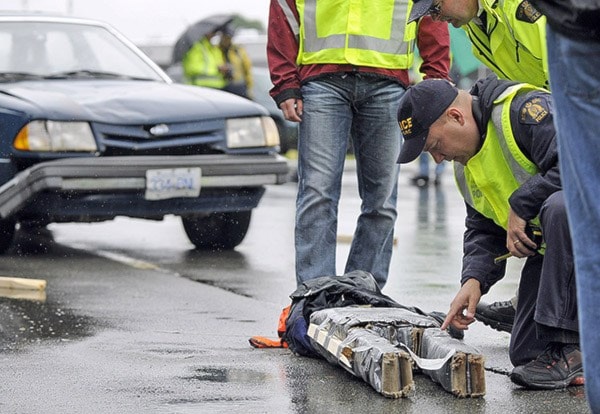There’s not much to see at 9 a.m. Thursday morning.
Rolling into the Pacific Region Training Centre (PRTC) parking lot on Calais Avenue, there’s a red brick building to the left and the administrative building straight ahead.
No people though, which seems odd.
There’s supposed to be 250-280 visitors on site this week, plus another 100 or so employees.
Where are they?
Well, turns out your lazy friendly neighborhood reporter should have rolled out of bed a bit earlier. The first wave of activity happens between 6 and 7 a.m. as officers-in-training head out for breakfast and then classes.
“The real hustle bustle is much earlier in the morning, and after 8 a.m. they’re all in their classrooms or scenario based training,” says PRTC Superintendent Michael Legault. “You won’t see them again until 10 to 10:30 a.m., when they get a break between classes.”
Development of the PRTC started in 2001 and culminated in 2006.
The PRTC occupies 60 acres and 33 buildings as part of the Canada Education Park on the old military base, and has continued to grow.
It is quietly one of Chilliwack’s economic giants, with an operating budget in the multi-millions. Its salary envelope, when you include PRTC and related public-safety employees within the Canada Education park, sits around $8,500,000.
“On top of that, there’s an Executive Inn here employing a variety of full and part time staff,” says Ken Burton, Officer in Charge of Support Services. “They provide full food service and housekeeping, with most of their staff living in the area.”
The on-site hotel is operated by Executive Hotels and Resorts. The hotel can accommodate 260 people. The re-purposed barracks can house another 120. The meal service can feed up to 400 people at a time, buffet style, in a spacious dining area. By the end of the year, the PRTC projects to sell around 42,000 hotel-room nights.
“They come here for anywhere from one night to four weeks, and as much of a beautiful facility as this is, you don’t spend more than two or three days without wanting to see the rest of the community,” Legault says. “Where we’re situated, we’re right beside the Vedder River. Cultus Lake is nearby. It is work for our visitors, but they have hours afterward where they can take time for themselves and enjoy Chilliwack.”
On this particular day, most of the visitors are going through operational training.
One third of the province’s police officers will rotate through the facility in a year, approximately 52 week participating in five days of activities, from scenario-based training to physical assessments to firearms qualifications.
Tactical teams from Correctional Services Canada are on site, using the PRTC facilities for their training. Another room is full of managers and supervisors taking part in a riveting human resources workshop.
And this is on a quiet week.
SAR Scene, a gathering of Search and Rescue workers, was held Oct. 19-21.
It was much busier then, with 500+ people on site, pushing the PRTC beyond the limits of its impressive capacity.
“We estimated somewhere around 600-1000 hotel rooms were transferred into are hotels because we couldn’t accommodate them here,” Burton said.
Cooperation from the neighboring Justice Institute of BC and University of the Fraser Valley campuses was required.
“SAR Scene wouldn’t have been as successful as it was without their help,” Burton noted. “The synergy that comes out of here is quite remarkable, and I’d say quite unique in Canada.”
There are other facilities on the site that are part of the corporate infrastructure, but don’t report directly to Legault and Burton.
The post-garage takes regular vehicles and gets them police ready, adding the flashing lights, collision bumpers and other bells and whistles.
The post-garage has 15 employees. Two more are employed in the storage operation., where PRTC keeps day-to-day stuff on hand, then sends it out to detachments as needed.
The Canadian Police College employs three.
There’s even an on-site audio/visual production unit (employing four), capable of producing public safety training films for the RCMP and other user groups (including the provincial and federal governments).
A 25 year master campus plan exists, providing a conservative projection (one per cent) and guideline to future PRTC growth.
“We always re-profile what we have to enhance and maximize its use, and the facility is running very smoothly right now,” Legault said.
Expansion would come on the western side of the PRTC map.
There is space next to the football field that will be used in the future. Land adjacent to the driving track is always in play for future expansion, and the RCMP is also eyeing other areas within the Canada Education Park.
“The University of the Fraser Valley has some footprints that don’t fit within the model they have, and they’re looking at an area that we might have,” Legault says. “So there’s that synergy, where we have those conversations and, in some cases, make arrangements to transfer lands and make it work for each group.”
“These negotiations always happen in concert with CEPCO (Chilliwack Economic Partners Corporation) and the City of Chilliwack,” Burton added. “CEPCO has been critical in allowing us to advance a professional and economically viable site.”
So what will the PRTC site look like 10 years out.
Legault says they will be looking to cement more partnerships with provincial and federal entities, which would naturally lead to the need for more scenario-based training, more classrooms and more hotel rooms.
Whatever they do will be watched carefully by groups around the world who wish to mimic the PRTC and Canada Education Park model.
“We’ve had visitors from as far abroad as Abu Dhabi and Australia,” Burton says. “Swedish police have come here to try and understand our business relationship, learning from our mistakes and our best practices. There’s only a couple facilities worldwide that have this kind of structure, and we get plenty of attention because of it.”
